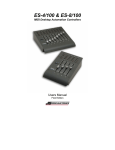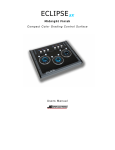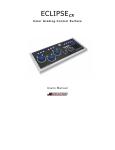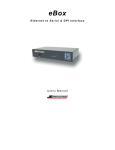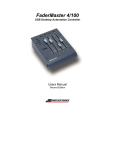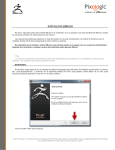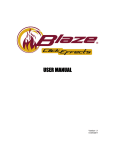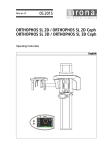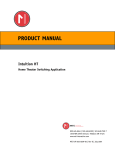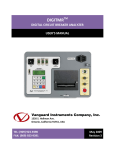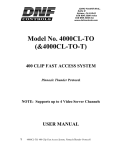Download KeyShot and RackShot Users Manual
Transcript
KeyShot and RackShot Ta c t i l e G r a p h i c C o n t r o l S u r f a c e s Users Manual KeyShot, RackShot, MCS-QuickShot, MCS-ClipShot, MCS-3800, MCS-3400 and MCS-3000 are trademarks of JLCooper Electronics. All other brand names are the property of their respective owners. KeyShot and RackShot User’s Manual, Preliminary Edition (October 21, 2004) Part Number 932096 2004 JLCooper Electronics, 142 Arena Street, El Segundo, CA 90245 USA (310) 322-9990 ¬ (310) 335-0110 www.jlcooper.com 2 Table of Contents Introduction................................................................................... 4 Unpacking...................................................................................... 5 Setup............................................................................................... 5 Installation ..................................................................................... 6 Connecting the KeyShot.............................................................. 6 Controller Modes of Operation ................................................... 7 Using as a Host Controller ........................................................... 7 Technical Reference...................................................................... 8 Connections................................................................................. 8 KeyShot Series RS-422 Interface Card................................... 8 KeyShot Series RS-232 Interface Card................................... 9 KeyShot Series USB Interface Card ....................................... 9 KeyShot Series Ethernet Interface Card ............................... 10 Troubleshooting ........................................................................ 19 Care and Service....................................................................... 20 3 Introduction Thank you for purchasing the KeyShot or RackShot. These two products allow you to control video, audio and show control applications in an intuitive manner. No longer do you have to use a mouse and keyboard to cue clips, you can now use a tactile interface with graphic buttons in a compact size. The KeyShot and RackShot are identical products in different chassis. The KeyShot is housed in a compact desktop style package that is intended to fit behind a computer keyboard. The power and interface connectors are located on the right side to allow the unit to sit flat against a wall or monitor. The RackShot is housed in a 1U high rack mount enclosure. The KeyShot and RackShot have numerous interface options. Each has a slot to accommodate the smaller MCS-Interface Cards. These are available in: • • • • RS-232 RS-422 USB Ethernet 4 Unpacking When you receive your KeyShot or RackShot, you should receive the following items: • • • KeyShot or RackShot This Users Manual Power supply appropriate for your location If you have also purchased any optional MCS-Interface cards with the KeyShot or RackShot, the card may be preinstalled. Please take a moment to register your product at: http://www.jlcooper.com This will allow us to notify you of important updates and changes to software or features. Setup An interface card, which communicates with the host or a controlled device (VTR, switcher, etc), must be installed. To install the interface card: 1. Unplug the power cable from the unit. 2. Remove 2 screws attaching the blank plate to the side of the unit. 3. Slide Interface Card into unit. 4. Replace 2 screws that secure card to unit. 5 Installation Connecting the KeyShot Connecting the KeyShot is straightforward. If you are using RS-422 to connect to your Odetics compatible decks or video servers, install the RS-422 interface into the interface slot. Make sure that the jumpers on the RS-422 interface are set to “Machine”. If you are using RS-232 to connect to a host computer, use a standard, straight through, female to female, 9 pin D-Sub cable. Do not use a null modem cable. Configure your host serial port to communicate at 38400 bits/sec, 8 data bits, odd parity and one stop bit. If you are using USB to connect to a host computer, use a standard USB A-B cable. A driver is available which maps the KeyShot or RackShot to a serial port in Windows 95, 98, Me, 2000 and XP. Consult your application documentation for more details to on how configure your KeyShot or RackShot for your application. The drivers can be downloaded from: http://www.jlcooper.com/pages/downloads.html If you are using Ethernet to connect to a host computer, use a standard Ethernet cable. A driver is available which maps the KeyShot or RackShot to a serial port in Windows 95, 98, Me, 2000 and XP. Consult your application documentation for more details to on how configure your KeyShot or RackShot for your application. The drivers can be downloaded from: http://www.jlcooper.com/pages/downloads.html 6 Controller Modes of Operation The KeyShot and RackShot can operate either as a generic controller or as an Odetics controller. As a generic controller, the KeyShot and RackShot connect to a host computer, which acts on button presses and sends feedback to the KeyShot or RackShot in the form of text or graphics on the 10 LCD buttons. As an Odetics controller, the KeyShot or RackShot can control a VTR, audio deck, video server that supports the Sony 9 pin P2 or Odetics protocol. In the Odetics mode, an KeyShot Series RS-422 Interface Card must be installed. To switch between the two modes of operation, press SHIFT and F4 simultaneously. Turn the knob to scroll between the different modes. When the desired mode is displayed, press SHIFT to select that mode. The mode change occurs immediately. Using as a Host Controller Since the functionality of the KeyShot or RackShot is defined by the host application, please refer to your host applications documentation for details on how to use the KeyShot or RackShot with your application. 7 Technical Reference Connections KeyShot Series RS-422 Interface Card The RS-422 Interface is intended for operation with a VTR, controller or a host computer. It provides the advantages of RS422, which allows for long cable runs. With low loss, low capacitance cable, the RS-422 Interface Card can accommodate cable runs up to 1km. The RS-422 Interface has a female, 9 pin, D-Sub connector. The interface can be configured to connect to either a deck or a host. Five jumpers on the interface card configure the pinout. All five jumpers must be places in either the “To Computer” or “To Machine” position. The port is set to communicate at 38400 bits/sec, 1 start bit, 8 data bits, 1 stop bit and odd parity. MCS-RS422 Interface Pinout Setting on Card 1 2 3 4 5 6 7 8 9 “To Computer” “To Machine” Ground Ground Transmit A Receive A Receive B Transmit B Ground Ground not used not used Ground Ground Transmit B Receive B Receive A Transmit A Ground Ground Note: These signals are at the RS-422 Interface card. 8 KeyShot Series RS-232 Interface Card The RS-232 Interface is intended for operation with a host computer. It provides the advantages of a standard interface, which is found on many computers. The RS-232 Interface has a male D-Sub connector. The port is configured to communicate at 1 start bit, 8 data bits, 1 stop bit and odd parity. The port is set to communicate at 38400 bits/sec, 1 start bit, 8 data bits, 1 stop bit and odd parity. MCS-RS232 Interface Pinout 1 2 3 5 6 8 DCD* Transmit Receive Ground DSR* CTS* Note: These signals are at the RS-232 Interface card * These pins are not used by the card and are connected together for ports that require handshake. KeyShot Series USB Interface Card The USB Interface is intended for operation with a host computer. It provides the advantages of a standard interface, which is found on most modern computers. The USB Interface has a female USB B type connector and uses the USB v1.1 protocol. For Windows computers, there is a driver that allows the device with this interface card to appear as a com port. This driver can be downloaded from the JLCooper support web site, http://www.jlcooper.com/pages/downloads.html. With the driver, the virtual com port is configured to communicate at 38400 bits/sec, 1 start bit, 8 data bits, 1 stop bit and no parity. 9 KeyShot Series Ethernet Interface Card The Ethernet Interface is intended for operation with a host computer. It provides the advantages of a standard interface, long cable runs, use over private/public/wired/wireless networks, the ability of being shared among computers and the ability to work with any platform that supports TCP/IP. To use the Ethernet Interface, the software application MUST be written to specifically support the Ethernet Interface. Consult your software’s users documentation for details on how to configure the software to operate with the KeyShot or RackShot. To configure the KeyShot or RackShot Ethernet settings, an Ethernet Interface card must be installed. You can verify this by visually checking the slot for the presence of an Ethernet card. To set the IP address, use the provided Lantronix XPort Installer and Redirector utility. Note: Do not use this driver concurrently with the USB Virtual COM Port or any other device that uses a virtual COM port. There are two basic steps to setup the controller to communicate with the host: 1. Configuring the KeyShot or RackShot. This involves setting the IP address and, optionally, TCP port. 2. Installing and configuring the driver. This involves setting the Windows driver to associate a COM port with the IP address and TCP port of your controller. Note: Before configuring your JLCooper Ethernet based controller, you will need a unique IP address for each controller you wish to use. Your network administrator can supply this to you. Install the Lantronix XPort Installer and Redirector utility. This is located on the Install CD or can be downloaded from: http://jlcooper.com/pages/downloads.html. 10 1. Launch the XPort Installer. 2. Click on Search to look for your Ethernet Controller. 3. Click Assign IP address. 11 4. Select the XPort item that corresponds to the hardware or MAC address of your JLCooper Ethernet Controller and click on Assign IP. The hardware or MAC can be found on the Ethernet card. 5. Enter the IP address you want assigned to your Ethernet Controller and click OK. In this example, we are using 192.168.254.165 however, you can use any address. 6. Your device will disappear momentarily from the XPort Installer window and reappear. During this time, the status bar in the bottom left corner of the window will display “Waiting for reboot…”. 12 7. Set Port Configuration 8. Select the XPort item that corresponds to the hardware address of your JLCooper Ethernet Controller. 13 9. Click on Ports then click on . Odd 10. Confirm the settings: Local Port = 10001* Baud Rate = 38400 Data bits = 8 Flow control = None Parity = Odd Stop bits = 1 * Note: The Local Port can be any 16 bit, nonzero integer. This same port number MUST match the port number you specify in the Redirector below. 11. Click OK then click Update to save the changes in the Ethernet Controller. 14 12. Launch the Lantronix Redirector Configuration 13. Assign a COM port to the Ethernet Controller. 14. Click on the Com Setup button. 15 15. Select the COM port you want your Ethernet controller to appear as. Ports that are already used by other devices are grayed out. Click OK. 16. Click Add IP. 17. Enter the IP address and TCP port of your Ethernet controller. This is the Local Port you entered in the XPort Installer or Device Installer. If you configured a different port number in the XPort Installer or Device Installer application, enter that number in the TCPPort box. Click OK. 16 This main window will now have an entry in the Port Configuration window. 18. Click on Port Settings. Check the Raw Mode box. Click OK. Click Save in the main window. Your Ethernet controller is now configured to appear as a COM port. You can verify this by selecting the COM port associated with your Ethernet Controller. A dialog box will appear to let you know that the driver is attempting to establish a connection with the Ethernet Controller. If a connection can be made, the following dialog box will appear. 17 Additionally, the status box in the Redirector window look like: If the attempt was not successful, the following dialog box will appear: Lastly, the following dialog box will appear when the COM port is closed: Note: These dialog boxes can be disabled by placing a check in the Silent Mode box in the Redirector main window. 18 Power The KeyShot and RackShot requires a 5 volt DC supply capable of delivering at least 1 amp. The unit comes with a power supply appropriate for the country in which the unit was sold. If you need a power supply specific to your location, please contact your local distributor or JLCooper Electronics. Location North America Europe JLCooper Part Number 561027 561027 Table 2: JLCooper approved Power Supplies Warning: Using a power supply other than the units specified in the above table can result in damage to the KeyShot and/or other equipment which is not covered by the JLCooper Factory Warranty. Troubleshooting If for some reason the KeyShot or RackShot does not give you the expected results, take a moment to do some investigating. The most important concept is that you have your KeyShot or RackShot connected properly as outlined in Installation and Use. Take a moment to double check your setup. A common problem is forgetting to turn the power switch on or turning the unit on after the software application has launched. In addition, the JLCooper website (www.jlcooper.com) will contain up to date information on drivers, applications and troubleshooting. If all else fails, you can contact the JLCooper Service Department at: [email protected]. 19 Care and Service If properly cared for, your KeyShot or RackShot should provide years of troublefree performance. While the KeyShot and RackShot are built in rugged metal enclosures, please avoid dropping the KeyShot or RackShot. Clean with a soft, damp cloth. Do not allow liquids, dust or other foreign matter to get inside the unit. There are no user-serviceable parts in the KeyShot or RackShot. Please refer to the JLCooper Electronics Limited Factory Warranty on the following page for detailed warranty and service information. 20 JLCooper Electronics Limited Factory Warranty JLCooper Electronics ("JLCooper") warrants this product to be free of defects in materials or workmanship for a period of 12 months from the date of purchase. This warranty is non-transferable and the benefits apply only to the original owner. Proof of purchase in the form of an itemized sales receipt is required for warranty coverage. To receive service under this warranty, customers in the United States should contact the JLCooper factory at (310) 322-9990 and talk to a service technician. If necessary, a Return Authorization number may be issued. For our customers outside the United States, it is recommended that you first contact your Dealer or Distributor, since they may offer their own service or support policy. If local support is not obtainable, please send a FAX to JLCooper's Service Department at +1 310 335 0110 with a detailed description of the service required. Upon issuance of return authorization, the product should be packed in the original shipping materials and shipped prepaid and insured to: Service Department, JLCooper Electronics, 142 Arena Street, El Segundo, CA 90245. Please include the following: copy of the sales receipt, your name and address (no P.O. Boxes, please), a brief description of the problem, and any other related items discussed with the service department and considered necessary to evaluate the product or effect a repair. The return authorization number must be clearly written on the outside of the package. JLCooper will at its option, without charge for parts or labor, either repair or replace the defective part(s) or unit. Shipping costs are not covered by this warranty. JLCooper's normal repair turn around time at the factory is approximately 15 business days from receipt of product to shipping. Your actual turn around time will include return shipping. Actual turn around time will vary depending upon many factors including the repeatability of the customer's reported complaint, the availability of parts required for repair, the availability of related products needed to evaluate the product if necessary. Priority services are available at additional cost. These should be discussed with the service technician at the time the return authorization is issued. This warranty provides only the benefits specified and does not cover defects or repairs needed as result of acts beyond the control of JLCooper including but not limited to: abuse, damage by accident/negligence, damage from using incorrect power supply, modification, alteration, improper use, unauthorized servicing, tampering, or failure to operate in accordance with the procedures outlined in the owner's manual; nor for natural or man-made events such as, but not limited to flooding, lightning, tornadoes, earthquake, fire, civil unrest, war, terrorism, etc. THE DURATION OF ANY OTHER WARRANTIES, WHETHER IMPLIED OR EXPRESS, INCLUDING BUT NOT LIMITED TO THE IMPLIED WARRANTY OF MERCHANTABILITY, IS LIMITED TO THE DURATION OF THE EXPRESS WARRANTY HEREIN. JLCOOPER HEREBY EXCLUDES INCIDENTAL AND CONSEQUENTIAL DAMAGES, INCLUDING BUT NOT LIMITED TO: LOSS OF TIME, INCONVENIENCE, DELAY IN PERFORMANCE OF THIS WARRANTY, THE LOSS OF USE OF THE PRODUCT OR COMMERCIAL LOSS, AND FOR BREACH OF ANY EXPRESS OR IMPLIED WARRANTY OF MERCHANTABILITY APPLICABLE TO THIS PRODUCT. JLCOOPER SHALL NOT BE LIABLE FOR DAMAGES OR LOSS RESULTING FROM THE NEGLIGENT OR INTENTIONAL ACTS OF THE SHIPPER OR HIS CONTRACT AFFILIATES. THE CUSTOMER SHOULD CONTACT THE SHIPPER FOR PROPER CLAIMS PROCEDURES IN THE EVENT OF DAMAGE OR LOSS RESULTING FROM SHIPMENT. THIS WARRANTY SHALL BE GOVERENED BY THE LAWS OF THE STATE OF CALIFORNIA. 21























